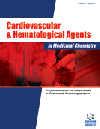- Home
- A-Z Publications
- Cardiovascular & Hematological Agents in Medicinal Chemistry (Formerly Current Medicinal Chemistry - Cardiovascular & Hematological Agents)
- Previous Issues
- Volume 13, Issue 1, 2015
Cardiovascular & Hematological Agents in Medicinal Chemistry (Formerly Current Medicinal Chemistry - Cardiovascular & Hematological Agents) - Volume 13, Issue 1, 2015
Volume 13, Issue 1, 2015
-
-
Ivabradine for Treatment of Coronary Artery Disease: From Last Chance Resort to Mainstem of a Reasoned Therapy
More LessAuthors: Alessandro Lupi, Andrea Rognoni, Chiara Cavallino, Gioel G. Secco, Roberta Rosso and Angelo S BongoHeart rate is a fundamental determinant of cardiac oxygen consumption and plays a pivotal role in the pathophysiology of chronic stable angina (CSA). Ivabradine selectively and specifically inhibits the sino-atrial If current, slowing selectively heart rate without other significant haemodynamic effects. The consequent clinical effects are a sinus rate reduction similar to that obtained with beta-blockers, but without the related hae Read More
-
-
-
Pathophysiology of Atherosclerotic Plaque Development
More LessCardiovascular diseases and in particular coronary atherosclerotic disease are the leading cause of mortality and morbidity in the industrialized countries. Coronary atherosclerosis has been recognized for over a century and it was the subject of various studies. Pathophysiological studies have unravelled the interactions of molecular and cellular elements involved in atherogenesis; during the last decades the basic researc Read More
-
-
-
New Anti-Anginal Drugs: Ranolazine
More LessChronic angina represents a condition that impairs quality of life and is associated with decreased life expectancy in the industrialized countries. Current therapies that reduce angina frequency include old drugs such as nitrates, β -blockers and calcium antagonists. Several new investigational drugs are being tested for the treatment of chronic angina. This review will focus on ranolazine, a drug approved by the US Food and Dr Read More
-
-
-
Old and New Drugs for Treatment of Stable Angina: New Anti-Anginal Drugs and Coronary Revascularization
More LessSince the first human catheterization performed by Forssman in 1929 angioplasty equipment and medical therapies have undergone considerable evolution and technical improvement allowing interventionalists to perform more complex procedures and solving most of the percutaneous limitations. While percutaneous coronary intervention (PCI) has dramatically changed the outcome in the Acute Coronary Syndrome (AC Read More
-
-
-
Beta-Blockers and Nitrates: Pharmacotherapy and Indications
More LessMany clinically important differences exist between beta blockers. B1-selectivity is of clinical interest because at clinically used doses, b1- selective agents block cardiac b-receptors while having minor effects on bronchial and vascular b-receptors. Beta-adrenergic blocking agents significantly decrease the frequency and duration of angina pectoris, instead the prognostic benefit of beta-blockers in stable angina has been extra Read More
-
-
-
Ranolazine and its Antiarrhythmic Actions
More LessAuthors: Kali Polytarchou and Antonis S. ManolisRanolazine, a newly introduced, FDA-approved antianginal agent, has more recently been shown to have additional beneficial antiarrhythmic actions attributed to its inhibitory effect on both peak and late sodium current. The first clinical evidence of ranolazine’s antiarrhythmic efficacy has been provided by the MERLIN-TIMI 36 trial, which showed that ranolazine may suppress both supraventricular and ventricular arrhythmi Read More
-
-
-
Current Status of Antiplatelet Therapy in Acute Coronary Syndrome
More LessAntiplatelet therapy is a first-line medical treatment for patients with acute coronary syndrome (ACS). As percutaneous coronary interventions (PCI) increase in number and complexity, more patients must be treated with antiplatelet therapy for cardiovascular diseases in which arterial thrombosis plays a major role. Current anti-platelet therapy is highly effective in preventing atherothrombotic complications. Neverthele Read More
-
-
-
Systemic Hypertension in Patients with Aortic Stenosis: Clinical Implications and Principles of Pharmacological Therapy
More LessAuthors: Sucheta Gosavi, Rahul Channa and Debabrata MukherjeeThe treatment of systemic hypertension (HTN) in patients with Aortic stenosis (AS) requires a careful balance of lowering the systemic blood pressure without compromising vital organ perfusion and worsening of the symptoms of AS. Treatment of systemic HTN is beneficial because the combination of HTN and AS provides additional overload to the left ventricle. This leads to secondary Left ventricular hypertrophy (LVH), Read More
-
-
-
Calcium Channel Blockers – Benefits Upon Vascular Biology in Hypertensive Patients
More LessCalcium channel blockers (CCB) are widely used in cardiovascular medicine expressing high hopes upon decreasing cardiovascular risk, morbidity and mortality. Here, the potency of CCBs on 58 Romanian asymptomatic hypertensive patients, with no atherothrombotic cardiovascular disease, was studied by clinical and in silico methods. In our study, arterial elasticity/stiffness was assessed; anthropometric, metabolic (lipidic) pa Read More
-
-
-
First Comprehensive Analysis of Outcomes in Adult Patients after Percutaneous Closure of Isolated Secundum Atrial Septal Defects
More LessAuthors: Armita Atashband and Nasser LakkisBackground: Secundum atrial septal defect (ASD) is a common congenital heart defect in adults. If untreated, ASD leads to right ventricular (RV) failure, atrial arrhythmias, and pulmonary hypertension. The aim of this study is to analyze published data on outcomes and complications of percutaneous ASD closure in adults. Methods: PubMed searches performed for published literature on percutaneous ASD closure using t Read More
-
Volumes & issues
-
Volume 23 (2025)
-
Volume 22 (2024)
-
Volume 21 (2023)
-
Volume 20 (2022)
-
Volume 19 (2021)
-
Volume 18 (2020)
-
Volume 2 (2020)
-
Volume 17 (2019)
-
Volume 16 (2018)
-
Volume 15 (2017)
-
Volume 14 (2016)
-
Volume 13 (2015)
-
Volume 12 (2014)
-
Volume 11 (2013)
-
Volume 10 (2012)
-
Volume 9 (2011)
-
Volume 8 (2010)
-
Volume 7 (2009)
-
Volume 6 (2008)
-
Volume 5 (2007)
-
Volume 4 (2006)
Most Read This Month
Article
content/journals/chamc
Journal
10
5
false
en


